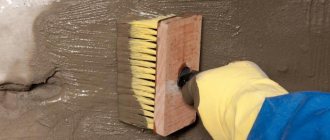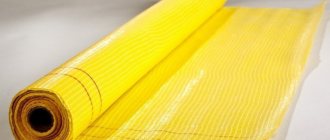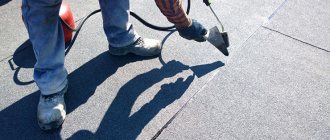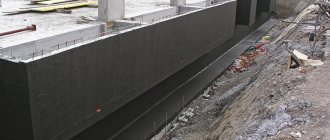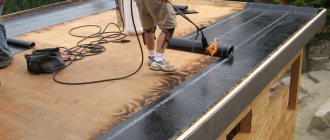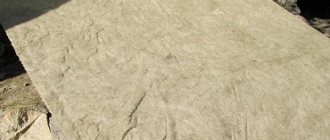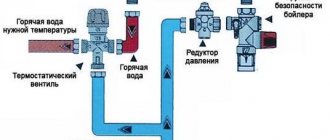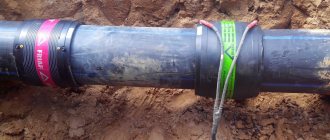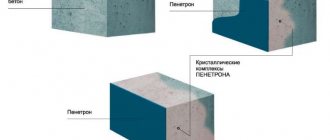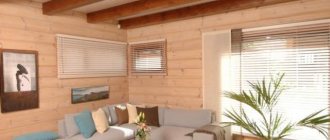Now it has become very fashionable to have a swimming pool in your suburban area. Why not? Why not create a full-fledged place for taking water procedures? Especially if you do it yourself or with some outside help. But remember: pool waterproofing must be done on time. Otherwise, this “newfangled thing” will not please you for long. Don’t delay this process: waterproof the pool before you start using it.
Types of waterproofing
If the pool is located inside a structure, then only internal waterproofing is performed to protect the surface of the pool from the negative effects of water penetrating through (possibly) poor-quality materials or cracks. And, if the pool is located outside, then in addition to the internal one, it is necessary to carry out external waterproofing, which protects the bowl of the concrete pool from groundwater and all the aggressive elements contained in it.
That is, the purpose of waterproofing is to make concrete waterproof. The strength and durability of the concrete pool as a whole depends on how well and correctly it is performed.
Important! If cracks larger than 4 mm appear during the operation of the pool, then it is unlikely that any pool waterproofing will solve this problem. In this case, more “drastic” measures will have to be taken.
Bitumen waterproofing
Plastimul 2K
A two-component bitumen emulsion designed for external waterproofing of swimming pools, concrete tanks and wells from aggressive waters. Does not contain solvents. Easy to apply. Suitable for sealing cracks. It has thixotropic properties and can be applied to vertical surfaces. The price is for a set of components A+B (30 kg).
Plastimul 2K Super
Bitumen emulsion for external waterproofing of swimming pools, concrete tanks, wells for protection against aggressive waters. Consists of two components. Does not contain solvents. Very elastic. Easy to apply. Consumption depends on the type of base and layer thickness. The price is for a set of components A+B (30 kg).
Classification of materials for waterproofing
By application
All used waterproofing materials are divided into two main groups:
- bitumen;
- polymer.
Insulating bitumen is a material obtained by blowing tar with hot air. For your information: tar is obtained by heating the last fraction formed during oil refining in a vacuum to a very high temperature (exceeding 400 degrees). The main feature of insulating bitumen (a resin-like substance) is that it does not dissolve in water. After applying it to the surface, it forms a durable and waterproof coating that is not subject to corrosion.
Practice shows that the use of such waterproofing can significantly increase the service life of the pool and guarantee its long-term operation even in conditions of constant contact with groundwater. Rolled and coating materials (mastics) are made from bitumen.
Polymer waterproofing includes compositions based on polyurethane. Once this material is applied to the surface, it interacts with air and transforms into a polymer film that protects against moisture. Polymer waterproofing is a universal coating and has a number of advantages:
- good elasticity;
- durability (service life more than 15 years);
- has excellent adhesion to materials such as ceramic tiles, concrete, glass and brick;
- resistant to temperature changes;
- easy to apply (due to the fact that the composition is a liquid or semi-liquid substance).
Polymer insulation can be coated or sprayed. On the construction market it is presented in the form of mastics and sealants. Using mastic, you can cover rather uneven and hard-to-reach surfaces with a protective layer. Sealant is a more viscous “representative” of polymer waterproofing, which can be easily applied to a surface of any geometric shape (for example, it can be used to insulate joints and seams). Liquid rubber also belongs to the category of polymer waterproofing.
By method of application
According to the method of application, materials are divided into:
- coating;
- sprayed;
- roll
Coating compositions (penetrating impregnations, bitumen and polymer mastics) are used to create a seamless monolithic layer. Most often, one- or two-component cement-polymer waterproofing is used, which can be used to thoroughly seal pores and small cracks formed in concrete. Coating materials, which have a relatively low cost, can provide high-quality protection of the hot tub with minimal labor costs: after all, you can apply several layers of mastic with a brush or spatula on your own.
Rolled materials (roofing felt, film membrane, PVC film) are used for arranging the protection of the pool both from the outside and from the inside. However, using such materials, you will not be able to avoid the presence of seams in the insulation.
Advice! We lay the rolled materials in two layers to overlap the seams.
Popular insulation materials
High-quality waterproofing of a swimming pool can be achieved in several ways. They all have certain advantages and disadvantages. To choose the best option you need to get to know each of them.
Option #1 - cement-based materials
Materials based on a cement-sand mixture are used as insulation. Most often these are two-component film polymer-cement compositions made on the basis of vinyl acetate and synthetic resin. The advantages of insulation include:
- High strength and reliability, allowing the material to withstand dynamic and static loads.
- Good adhesion to various surfaces.
- Long service life and maintainability.
- Good vapor permeability, which solves the problem of the formation of unwanted bubbles and swelling on the surface.
- Environmental friendliness of the material.
- Possibility of application on wet surfaces.
The biggest disadvantage of the material is considered to be low elasticity, which makes the compositions ineffective in areas of stress concentration. Therefore, they are used in combination with more elastic sealants, which are used to isolate and seal junctions, seams and similar areas. They become additional unloading belts. An important feature of cement-based insulating compositions is the ability to combine the functions of waterproofing and tile adhesive.
Low elasticity and insufficient resistance to dynamic and hydrostatic loads are the main disadvantages of cement-based waterproofing
Option #2 - penetrating insulation for concrete bowls
The materials contain chemically active compounds, including modifiers, which, when contacted with a concrete surface, begin to spread very quickly through the pores. After solidification, water-insoluble crystals are formed that completely fill pores, microscopic cracks and other cavities.
The advantages of penetrating materials are:
- Vapor permeability, allowing concrete to “breathe”.
- Good adhesion to the base.
- Continuous, seamless layer of insulation.
- Resistance to aggressive environments.
- The ability to apply the composition to surfaces of any shape, even very complex ones.
- Long service life.
- Preventing the appearance of fungus and mold.
- Possibility of application on a damp base.
The insulation forms a good base for plaster. The disadvantages of the material include the inability to apply the composition to areas connecting concrete and elements of water supply equipment.
The active composition penetrates deeply into the pores of the base and, after hardening, forms crystals that tightly plug all cavities.
Option #3 - insulating PVC film
There are three types of insulating material. The most budget option is unreinforced film. It has the least strength and is most often used for prefabricated pools. Reinforced material is more durable because it is reinforced with polyester threads. Capable of withstanding fairly large loads without deformation. You can also find anti-slip film on sale that prevents the pool surface from slipping. The best option is a material with an acrylic coating, which prevents the proliferation of microorganisms and prevents fading.
PVC film acts as waterproofing and at the same time finishing the bowl. You can choose a plain material or find a coating that imitates stone, mosaic, etc.
The advantages of film insulation are:
- The ability to simultaneously act as a decorative coating and waterproofing.
- High frost resistance and resistance to aggressive environments.
- Low cost.
- Hygienic coating.
- Possibility of use both in the construction and reconstruction of swimming pools. The material can be laid over old finishes, for example, on tiles.
- Variety of colors and finishes. You can choose a plain film or a material that imitates mosaic, stone, etc.
The main disadvantage of the material is its relatively short service life. It is only 5-10 years. Over time, the surface of the film becomes scratched and the color intensity is lost. Another drawback is the rather labor-intensive installation. Most often it is carried out by professionals, since it involves the use of complex technologies, for example, welding joints with hot air. The slightest mistake will lead to moisture getting under the waterproofing carpet.
Option #4 - liquid rubber
The material is a bitumen-polymer aqueous elastomer emulsion. The solution is applied by spraying using a catalyst, which allows you to start a rapid decomposition reaction of the emulsion. As a result, water is pushed out of the composition, and the dry residue forms a waterproofing membrane.
The advantages of liquid rubber include:
- Resistance to various aggressive environments.
- Formation of a seamless continuous membrane, the thickness of which can be adjusted during the spraying process.
- High strength and reliability, long service life.
- Possibility of application to surfaces of any configuration.
- Completely waterproof.
- The material does not emit toxic substances. It is safe for humans.
- The ability to add the desired pigment to the solution, which allows you to obtain a coating of the desired shade.
A serious disadvantage of liquid rubber is its instability to UV radiation. The material must be coated with special means to protect against ultraviolet radiation. To apply the coating, special equipment is used, which can only be operated by specialists. In addition, before applying liquid rubber, careful preparation of the base is required.
Liquid rubber is applied by spraying using special equipment. The procedure is performed only by a specialist
Option #5 - liquid glass
This is an aqueous solution with sodium silicate, which fills all the pores and microcracks of the base well. The material is considered an excellent sealant; its crystalline structure provides reliable protection against moisture. It can also be used in the form of additives, impregnations and additives. The advantages of the coating include:
- Formation of a waterproof barrier.
- Easy to use.
- Antiseptic properties to prevent the growth of microorganisms.
- High level of fire resistance.
- Reliable adhesion to the base.
- Frost resistance.
- Low cost.
The disadvantage of liquid glass is rapid crystallization. The prepared working solution must be laid in a very short time. That is why it is best to entrust waterproofing work to a specialist. In addition, liquid glass quickly breaks down. Without protection, its service life will be only 5 years. To prevent this, it is recommended to cover the waterproofing with a protective layer of paint.
Liquid glass crystallizes very quickly, so it should be applied to the base almost immediately after preparing the working solution
Option #6 - latex membrane
It is a ready-to-use latex-based liquid. It comes complete with a special reinforcing fabric. The solution is applied to the junction lines and corners, which are glued with strips of fabric. Then the floor and walls of the pool are covered with a composition, on top of which the canvas is laid. Finally, everything is again covered with a layer of solution. After complete drying, a protective membrane forms on the surface of the bowl. Advantages of latex waterproofing:
- Forms a thin, waterproof, elastic, crack-inhibiting coating.
- Suppresses the growth of microorganisms.
- The material easily covers plastic inserts and cold seams.
- It has high strength and long service life.
The disadvantages of the coating are the high cost and complexity of application. The membrane cannot be laid on a damp surface.
The latex membrane is a liquid solution complete with a special reinforced fabric. The material provides an elastic, strong and durable insulating coating
External waterproofing technology
Before proceeding with arranging the protection of the font bowl from the inside, the external waterproofing of the pool is carried out:
- if the groundwater level is higher than the bottom slab, then we build a drainage system around the font;
- we perform concrete screed for the pool base;
- lay out the prepared roll material on the ground (according to previously taken measurements);
- We connect the seams using welding;
- We lay the external waterproofing, doing it with a large margin around the edges, so that later it can be placed on the walls of the pool and connected to the inner insulating layer of the bowl.
Important! Instead of rolled material, penetrating compounds can be used as external waterproofing, for example, mastics, which fill the smallest pores and cracks.
Applying polyurethane mastic to a concrete pool bowl
Substrate preparation : The surface of the base on which the mastic is applied must be prepared; it must be: smooth, free of dust, dirt, oils and debris. Particular attention should be paid to the humidity of the coating - it is not allowed to apply polyurethane mastic to a base with a humidity of more than 6%. If the base humidity is high, the waterproofing coating may subsequently peel off and bubbles may form. If the concrete base is loose and porous, then it must be cleaned to a durable layer.
It is also necessary to prime it in order to reduce mastic consumption and guarantee the quality of the mastic coating. We recommend using Ecoprime-EPO or Ecoprime 170 primer. When installing a waterproofing coating for a pool, it is recommended to pay special attention to joints and junctions with pipelines and other embedded elements of the pool.
Mixing components : Component A is mixed with a drill with a nozzle or a construction mixer until smooth, then component B is added while mixing and mixed for 2-3 minutes. Mixed components must be used within 20 minutes.
Application of mastic : The mastic is applied to the prepared surface in strips with overlapping layers, then distributed with a short-pile polymer roller, spatula, rubber squeegee, observing the recommended consumption of 0.6-1 kg per 1 m2 of surface. For waterproofing, 2 layers of mastic are sufficient, but in dangerous places, such as abutment joints, technological holes, etc., it is recommended to apply mastic, reinforcing with non-woven material or construction polymer mesh. For this purpose, fiberglass is applied to the still wet layer of mastic, pressed and covered with a layer of mastic on top. It is recommended to apply the second layer of mastic after the first has cured, but within an interval of up to 24 hours after applying the first layer.
Technology for arranging internal waterproofing
Internal waterproofing of a swimming pool is an important step in the construction of the entire facility. The technology for applying all kinds of coating materials is quite simple:
- after pouring the bowl (by the way, to increase the waterproofing properties of concrete, we add plasticizers and special additives to it) leave it for final drying;
- We seal small cracks and other defects with resin or sealant;
- we arrange the screed of the base of the font using a self-leveling solution;
- We carry out plastering work;
- we clean the surface of the bowl to make it rough (this is necessary for better adhesion of the protective coating to the concrete);
- remove dust and debris; degrease the surface;
- prime the inner surface of the pool bowl with a special compound;
- let the primer dry (drying time is indicated on the package);
- prepare the coating composition according to the instructions;
- We apply waterproofing in two or three layers, generously brushing the seams, small cracks, gaps and joints of the pool surface planes with a brush (each subsequent layer is applied only after the previous one has dried);
- after the waterproofing layer has completely dried, we check the pool for leaks;
- We carry out facing work.
On a note! Remember: “the miser pays twice,” so it is better to buy expensive coating materials (they are more effective), and in combination with fiberglass mesh they become more durable and elastic.
Types of pool waterproofing
The structure is protected from water from the outside and inside, and therefore the waterproofing materials used are divided into two groups.
External moisture protection of the bowl
External waterproofing is used to protect the structure from flood and groundwater. It is relevant for street structures buried in the ground. The requirements for external waterproofing are similar to those for moisture protection of foundations.
The main difference lies in the shrinkage rates and changes in the geometry of the bowl structure that occur under the influence of a significant mass of water. Before building a bowl, it is necessary to carefully study the soil structure in the selected area, find out the level of soil freezing, as well as the depth of groundwater.
It is very important that the level of the bottom plate of the bowl is not lowered below the depth of groundwater. If this is the case, waterproofing alone will not be enough. In this case, groundwater must be drained away from the structure using a drainage system.
The internal waterproofing of the bowl protects the structure not only from moisture, but also from the destructive effects of chemical reagents, and therefore must be resistant to them
The most proven and affordable method of arranging external waterproofing is considered to be a clay castle, which is installed directly during the construction period. After the soil is removed from the pit prepared for the pool, clay is poured into it and compacted thoroughly.
This is a clay castle. The best results can be achieved when it is used in combination with other insulating materials: pasting, coating or penetrating materials.
You need to choose the option of an external water barrier for the bowl at the design stage. After the construction of the pool, it is more expensive and more difficult to eliminate defects and apply material to the walls. And it will be completely impossible to protect the bottom.
Internal waterproofing of the pool
Internal insulation of the bowl is mandatory for any type of pool. The insulating layer protects the material from which the structure is made from the destructive effects of moisture and chemical compounds.
Most often, the composition includes protection against disinfectants, which will certainly be present in the water. The latter are relatively safe for humans, but are an aggressive environment for building materials.
Waterproofing not only protects the pool from moisture, but also from possible leaks and corrosion. Internal insulation will be considered high quality if it is resistant to opening holes and cracks up to 3 mm wide.
It is desirable that the waterproofing layer be low, but at the same time elastic. The material must have good adhesion to the base and maximum water resistance.
In addition, the insulating coating must resist hydrostatic and dynamic loads and fully comply with environmental standards. It would be nice if the waterproofing suppressed the activity of microorganisms. Another important nuance is full compliance with the type of finish chosen, otherwise it will be impossible to fully cladding the bowl.
Internal waterproofing of the bowl is applied at the final stages of pool construction. You can choose a material for it after all the work on the construction of the bowl has been completed, but always before cladding.
The most popular waterproofing materials
Liquid rubber
Liquid rubber is a bitumen-polymer mastic that has good waterproofing properties and combines the advantages of coating materials and roll materials. It is applied in several layers: the result is a pleasant-to-touch, dense and durable seamless coating.
Liquid rubber is a universal material in the sense that it can act as a finishing coating, that is, without subsequent decoration (just buy colored material), and as a base for tiles or mosaics.
Liquid glass
An aqueous alkaline solution of sodium or potassium silicates is nothing more than liquid glass, which is also known in the trade as silicate glue. Liquid glass in combination with cement-sand mortar creates a durable waterproofing coating. The advantages of silicate glue include the fact that it is relatively inexpensive, and the disadvantages are that this material, after mixing, hardens quickly (within 5 minutes) and is short-lived.
Liquid glass: a modern way of fast and effective insulation
If it is important for the owner of the site that the process of waterproofing pools is simple and does not take much time, then he should purchase liquid glass. This modern insulation material has received positive feedback from developers who appreciated its ease of use, high-quality insulation results and the low capital costs required for its implementation.
Liquid glass
The liquid glass jar contains a composition based on sodium and potassium silicates. It has a thick consistency and quite high density. The main feature of the composition is that the developer will be able to use it to isolate the hydraulic structure even at the stage of constructing the concrete bowl. The specificity of using the material is that it is added to the concrete solution, and then work is done to fill the base, bottom and sides of the bowl. Concrete with liquid glass in its composition acquires the following features:
— porosity and ability to absorb moisture decreases;
— improvement of strength characteristics;
— increasing resistance to loads and mechanical damage.
To achieve a more reliable result, upon completion of the construction of the bowl, another layer of liquid glass is applied over its walls and bottom. To evenly distribute the composition over the surface of the bowl, use a roller or brush. The work is carried out as follows:
— preparing the surface of the pool tank, cleaning it from debris and dust;
— removing grease stains from concrete pouring, cleaning it in order to improve the adhesive properties of the surface;
— preparing liquid glass for use in accordance with the manufacturer’s recommendations specified in the instructions;
- carefully apply the first layer, let it dry, uniformly apply the second layer.
Application of liquid glass
After this, the work is completed, and the developer will have access to all the bonuses that insulation made with liquid glass has. This protects the walls of the pool from leaks, chemical reactions, and UV rays.
PVC film as a material for waterproofing swimming pools: a review of advantages and disadvantages
Colorless thermoplastic PVC film, being resistant to chemicals, is a fairly common material in private and corporate construction. It is used for various purposes, including for DIY insulation of hydraulic structures. Properly applied film waterproofing protects a concrete pool, preventing leaks and damage to the integrity of the bowl.
The material has many advantages:
- is durable;
— meets modern quality standards;
- has decent performance characteristics - durability, light weight, tear resistance.
An additional advantage is the loyal price of this flooring. However, we must also not forget about the shortcomings. In order for the film to fulfill its function as an insulation material, you need to select it correctly in terms of density and carefully follow the installation technology. This will take a lot of effort and time. However, the end result is worth it - the pool will be reliably protected from leaks, and the owner will not have any unexpected troubles with major or routine repairs of the bowl.
The work technology has the following sequence:
— calculation of the required amount of film in accordance with the shape and configuration of the bowl, purchasing it at a construction center;
— preparing the bowl – cleaning the pool from debris, dust and other contaminants;
— fixing special brackets on the concrete walls and bottom of the pool - tapes, corners, hooks on which the PVC film will be fixed;
— geotextile flooring (the task of this layer is to prevent damage to the integrity of the film due to abrasion on the edges of the concrete bowl);
— the film is spread over the bowl and its parts are welded with a special soldering iron.
After the owner is convinced that all seams are reliable and sealed, the insulation work using PVC film is considered complete. Now you can proceed to the next steps.
